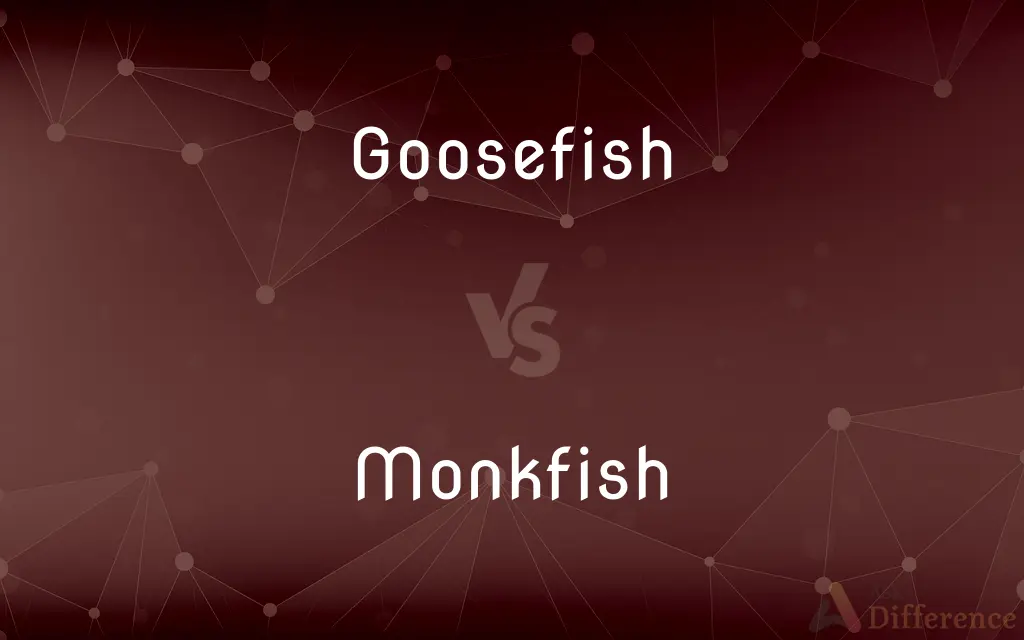Goosefish vs. Monkfish — What's the Difference?
By Maham Liaqat & Fiza Rafique — Updated on March 22, 2024
Goosefish and monkfish refer to the same species, Lophius americanus, known for its large head and mouth, utilized in culinary practices for its tail meat, often compared to lobster in texture.

Difference Between Goosefish and Monkfish
Table of Contents
ADVERTISEMENT
Key Differences
Goosefish and monkfish are two names for Lophius americanus, a species found in the Atlantic Ocean. This fish is characterized by its large head and mouth, which make up most of its body size. The names are used interchangeably, with "monkfish" being more commonly used in culinary contexts. This species is highly valued for its tail meat, which has a texture and taste reminiscent of lobster.
The term "goosefish" often highlights the fish's appearance, likening it to a goose due to its shape and size when out of water. In contrast, "monkfish" is thought to derive from the fish's resemblance to a monk in a cloak when viewed from above, emphasizing the cultural and regional differences in naming. Despite the differences in their names, both refer to the same fish and its unique characteristics.
In culinary circles, monkfish is prized for its firm, white flesh that stands up well to various cooking methods, including grilling, roasting, and poaching. While "goosefish" might be used in some regions or contexts, "monkfish" is the term most often found on menus and in recipes, reflecting the industry's preference for a name that may sound more appealing to consumers.
Both names may appear in discussions about seafood sustainability. Monkfish, or goosefish, has been subject to overfishing concerns, leading to regulations to ensure its populations remain healthy. This aspect underscores the importance of responsible fishing practices and awareness in preserving marine biodiversity, regardless of the name used.
The terminology used can also reflect regional preferences and traditions in seafood consumption. For example, in some coastal areas, the local population might be more familiar with the term "goosefish," using it in both commercial and recreational fishing contexts. On the other hand, "monkfish" is more universally recognized, particularly in international seafood markets, highlighting the global appeal of this fish.
ADVERTISEMENT
Comparison Chart
Scientific Name
Lophius americanus
Lophius americanus
Common Usage
Less common, regional
More common, especially in culinary contexts
Name Origin
Likened to a goose due to appearance
Thought to resemble a monk in a cloak
Culinary Preference
Same species, so culinary uses are identical
Preferred name in recipes and on menus
Sustainability and Conservation
Subject to the same fishing regulations and sustainability concerns
Same as goosefish, with efforts aimed at maintaining healthy populations
Compare with Definitions
Goosefish
Found in the Atlantic Ocean.
Goosefish are common in the cold waters of the North Atlantic.
Monkfish
Used in a variety of dishes.
Monkfish is versatile, appearing in stews, grills, and roasts.
Goosefish
Subject to fishing regulations.
Goosefish catches are monitored to prevent overfishing.
Monkfish
A fish prized for its lobster-like tail meat.
Monkfish tail is a delicacy in many seafood restaurants.
Goosefish
Valued for its tail meat in cooking.
The chef prepared a goosefish tail with a butter sauce.
Monkfish
Also caught in the Atlantic.
Sustainable monkfish fishing practices are important for ecosystem health.
Goosefish
Can be large, with some individuals weighing over 50 pounds.
The fisherman landed a massive goosefish last season.
Monkfish
Known for its ability to camouflage.
Monkfish can blend into the seabed to ambush prey.
Goosefish
A bottom-dwelling marine fish known for its large head.
Goosefish are often caught using bottom trawling techniques.
Monkfish
Has a unique, monk-like appearance.
Monkfish have a distinctive shape that some say resembles a monk.
Goosefish
Goosefishes are anglerfishes in the family Lophiidae found in the Arctic, Atlantic, Indian, and Pacific Oceans, where they live on sandy and muddy bottoms of the continental shelf and continental slope, to depths of more than 1,000 m (3,300 ft). Like most other anglerfishes, they have a very large head with a large mouth that bears long, sharp, recurved teeth.
Monkfish
See goosefish.
Goosefish
Any of several edible anglerfishes of the family Lophiidae, such as L. americanus of North American Atlantic waters, having a tapering body with a flattened head and a large mouth. Also called monkfish.
Monkfish
Any large bottom-dwelling anglerfish of the genus Lophius, such as Lophius piscatorius, of the Atlantic, having a large head and mouth.
Goosefish
An anglerfish of the family Lophiidae.
Monkfish
Angel sharks of the genus Squatina.
Goosefish
See Angler.
Monkfish
The angel fish (Squatina).
Goosefish
Fishes having large mouths with a wormlike filament attached for luring prey
Monkfish
Flesh of a large-headed anglerfish of the Atlantic waters of North America
Monkfish
Fishes having large mouths with a wormlike filament attached for luring prey
Monkfish
Sharks with broad flat bodies and winglike pectoral fins but that swim the way sharks do
Common Curiosities
Can goosefish be used in any recipe calling for monkfish?
Yes, since they are the same fish, the terms are interchangeable in recipes.
Are goosefish and monkfish the same species?
Yes, they are both names for Lophius americanus, a species valued for its tail meat.
Why is monkfish often compared to lobster?
Monkfish tail meat is firm and sweet, similar in texture and taste to lobster.
What is the significance of the names "goosefish" and "monkfish"?
"Goosefish" refers to its appearance, similar to a goose, while "monkfish" relates to its monk-like shape.
Where is monkfish found?
Monkfish are found in the North Atlantic, from Newfoundland to North Carolina.
Why might some menus prefer to list monkfish over goosefish?
"Monkfish" may be perceived as a more marketable name to consumers than "goosefish."
Are there any health benefits to eating monkfish?
Monkfish is low in fat and high in protein, making it a healthy seafood option.
Do goosefish and monkfish taste the same?
Yes, since they are the same fish, the taste is identical, often likened to lobster.
Is monkfish sustainable?
Monkfish is subject to regulations aimed at ensuring sustainable populations, but consumers should seek out sustainably sourced options.
How can consumers ensure they are buying sustainable monkfish?
Look for certifications or ask about the source to ensure the monkfish is sustainably caught.
How do you cook monkfish?
Monkfish can be grilled, roasted, poached, or used in stews, thanks to its firm texture.
What's the biggest threat to monkfish populations?
Overfishing and habitat destruction are major threats to sustainable monkfish populations.
Why is monkfish often used in fine dining?
Its unique taste and texture make monkfish a luxurious option for sophisticated dishes.
How does the appearance of a monkfish affect its marketability?
Despite its unappealing appearance, the high quality of monkfish meat makes it a popular choice in culinary circles.
Can monkfish be farmed?
Monkfish farming is not common, with most monkfish coming from wild catches.
Share Your Discovery

Previous Comparison
Double vs. Redouble
Next Comparison
Hem vs. HimAuthor Spotlight
Written by
Maham LiaqatCo-written by
Fiza RafiqueFiza Rafique is a skilled content writer at AskDifference.com, where she meticulously refines and enhances written pieces. Drawing from her vast editorial expertise, Fiza ensures clarity, accuracy, and precision in every article. Passionate about language, she continually seeks to elevate the quality of content for readers worldwide.














































